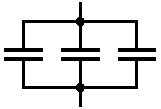Capacitors in Series and Parallel
When capacitors are connected in a circuit, their overall or combined capacitance can be calculated differently depending on whether they are arranged in series or parallel. Here's how you calculate combined capacitance for each type of connection:
1. Capacitors in Parallel

When capacitors are connected in parallel, their total (or equivalent) capacitance, Ctotal, is simply the sum of the individual capacitances. This is because the effective plate area increases when capacitors are connected in parallel, leading to greater capacitance.
Formula:
Ctotal = C1 + C2 + C3 + ........ + Cn
Where:
C1, C2, C3, .... are the capacitances of the individual capacitors.
Example:
If you have three capacitors in parallel with values C1 = 4uF, C2 = 5uF, and C3 = 10uF, the total capacitance is:
Ctotal = 4uF + 5uF + 10uF = 19 uF
2. Capacitors in Series

When capacitors are connected in series, the reciprocal (inverse) of the total capacitance is the sum of the reciprocals of the individual capacitances. This is because when capacitors are connected in series, the distance between the effective plates increases, reducing the total capacitance.
Formula:
1/Ctotal = 1/C1 + 1/C2 + 1/C3+ ...... + 1/Cn
Where:
C1, C2, C3, .... are the capacitances of the individual capacitors.
After calculating the sum of the reciprocals, take the reciprocal of that result to get the total capacitance.
Example:
If you have two capacitors in series with values C1 = 4uF and C2 = 6uF , the total capacitance is calculated as:
1/Ctotal = 1/4uF + 1/6uF
1/Ctotal = 0.25 + 0.1667 = 0.4167
Now, take the reciprocal of 0.4167 to get the total capacitance:
Ctotal} = 1/0.4167 or approx 2.4uF
Understanding this helps in designing circuits with the desired total capacitance by using available capacitor values.
If you are looking for capacitors to include in your project check out the Bitsbox capacitor section.
